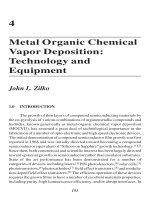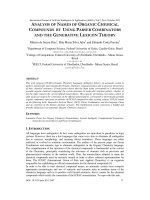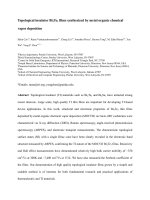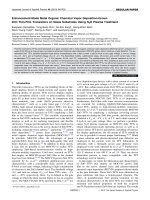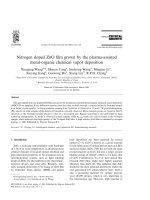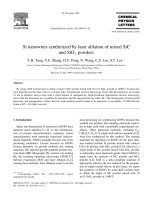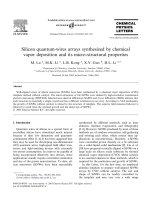Topological insulator Bi2Te3 films synthesized by metal organic chemical potx
Bạn đang xem bản rút gọn của tài liệu. Xem và tải ngay bản đầy đủ của tài liệu tại đây (524.36 KB, 14 trang )
Topological insulator Bi
2
Te
3
films synthesized by metal organic chemical
vapor deposition
Helin Cao
1,2
, Rama Venkatasubramanian
3,*
, Chang Liu
4,5
, Jonathan Pierce
3
, Haoran Yang
6
, M. Zahid Hasan
4,5
, Yue
Wu
6
, Yong P. Chen
1,2,7,*
1
Physics department, Purdue University, West Lafayette, IN 47907
2
Birck Nanotechnology Center, Purdue University, West Lafayette, IN 47907
3
Center for Solid State Energetics, RTI International, Research Triangle Park, NC 27709
4
Joseph Henry Laboratories, Department of Physics, Princeton University, Princeton, New Jersey 08544, USA
5
Princeton Institute for Science and Technology of Materials, Princeton University, Princeton, New Jersey 08544,
USA
6
School of Chemical Engineering, Purdue University, West Lafayette, Indiana 47907
7
School of Electrical and Computer Engineering, Purdue University, West Lafayette, IN 47907
*Emails: ;
Abstract: Topological insulator (TI) materials such as Bi
2
Te
3
and Bi
2
Se
3
have attracted strong
recent interests. Large scale, high quality TI thin films are important for developing TI-based
device applications. In this work, structural and electronic properties of Bi
2
Te
3
thin films
deposited by metal organic chemical vapor deposition (MOCVD) on GaAs (001) substrates were
characterized via X-ray diffraction (XRD), Raman spectroscopy, angle-resolved photoemission
spectroscopy (ARPES), and electronic transport measurements. The characteristic topological
surface states (SS) with a single Dirac cone have been clearly revealed in the electronic band
structure measured by ARPES, confirming the TI nature of the MOCVD Bi
2
Te
3
films. Resistivity
and Hall effect measurements have demonstrated relatively high bulk carrier mobility of ~350
cm
2
/Vs at 300K and ~7,400 cm
2
/Vs at 15 K. We have also measured the Seebeck coefficient of
the films. Our demonstration of high quality topological insulator films grown by a simple and
scalable method is of interests for both fundamental research and practical applications of
thermoelectric and TI materials.
For decades, Bi
2
Te
3
in its bulk form, and particularly their alloys have been known as one of the
best thermoelectric (TE) materials at ordinary temperatures (270 to 400 K) with high figure of
merit (ZT ~1)
1,2
. Recently, this material, thought to be a well-studied semiconductor, has been
discovered
3,4,5
as a new type of quantum matter, a 3D topological insulator (TI). Due to their
many remarkable properties
6,7,8,9,10
, topological insulators have currently emerged as one of the
most actively researched subjects in condensed matter physics. The bulk of a TI possesses an
insulating gap, whereas there exist non-trivial metallic surface states (SS) at the surface resulting
from an interplay between the topology of electronic band structure and strong spin-orbit
coupling in the bulk. The topological SS are protected by time-reversal symmetry, and therefore
cannot be destroyed by perturbations of non-magnetic impurities and small lattice defects.
Furthermore, such SS give rise to 2D Dirac fermions with spin-momentum locking and
suppressed back scattering, promising a host of novel physics and nano-electronics
devices
6,7,8,9,10
. The SS in Bi
2
Te
3
have been directly revealed by angle-resolved photoemission
spectroscopy (ARPES)
4
, scanning tunneling microscopy (STM)
11,12
, and magneto-transport
measurements have shown that the SS carrier mobility could reach as high as ~10,000 cm
2
/Vs
5
.
Synthesizing high quality materials is the foundation for exploiting the unique properties of
Bi
2
Te
3
for TI and thermoelectric device applications. High-quality Bi
2
Te
3
crystals can be grown
by the commonly-used Bridgeman technique
4,5,13
, however many applications (e.g. on-chip
electronics) desire large scale thin films. Various deposition techniques, such as sputtering
14
,
evaporation
15,16,17
, electrochemical deposition
18
, metal organic chemical vapor deposition
(MOCVD)
19,20,21
and molecular beam epitaxy (MBE)
22,23
, have been developed to grow
continuous Bi
2
Te
3
films on different substrates. Films grown by sputtering, evaporation, and
electrochemical deposition, offer room temperature (300 K) carrier mobility that are typically at
least 1 order of magnitude lower than that of bulk crystals (~ 300 to 600 cm
2
/Vs)
13,24,25
, and SS
have yet to be observed. MBE-grown films have shown mobility ~ 150 cm
2
/Vs at 300 K
24
, and
SS have been reported
26
. However, the relatively high cost and low yield of the MBE process can
limit its applications in industry. MOCVD has been successfully employed as an industrial
method for mass production of thin films and semiconductors. Recent developments in the
MOCVD technique have also demonstrated the growth of ultra-short-period superlattices in the
Bi
2
Te
3
system achieving one of the best thermoelectric performance (ZT ~ 2.4 at room
temperature)
20
. However, there have been little studies of such MOCVD Bi
2
Te
3
films from the TI
perspective. In this letter, we explore and report on such wafer-scale, high quality Bi
2
Te
3
thin
films grown by MOCVD on GaAs (001) substrates. The TI nature of such films is for the first
time directly demonstrated by ARPES. The carrier mobility is ~ 350 cm
2
/Vs at room temperature
and increases to ~ 7,400 cm
2
/Vs at 15 K, approaching some of the best values reported. We also
measured Seebeck coefficients of the film between 220K and 400K. Our results will be
important for understanding the structural and electronic properties of Bi
2
Te
3
films grown by
MOCVD and using such films in fundamental research and device applications incorporating
thermoelectric power and/or TI effects.
Heteroepitaxial Bi
2
Te
3
thin films were grown by “van der Waals epitaxy”
21
on GaAs (001)
substrates in a vertical, RF-heated, custom-built MOCVD reactor using a novel susceptor
design
21
. Prior to loading the GaAs substrates into the reactor chamber, an ex-situ cleaning
procedure was performed using solvents (trichloroethylene, acetone, and methanol) for
degreasing followed by a piranha etch to remove any remaining contaminants on the growth
surface. Trimethylbismuth (Bi(CH
3
)
3
) and diisopropyltelluride (Te(C
3
H
7
)
2
) were employed as Bi
and Te precursors respectively, transported and diluted using hydrogen gas. A deposition
pressure of 350 torr and deposition temperatures between 300°C and 400°C were utilized to
achieve heteroepitaxial c-plane orientated Bi
2
Te
3
films (photograph shown in the inset of Fig.
1b). As-grown films with ~1 µm thickness were cut into smaller pieces for various
measurements. We will present the experimental results from the following measurements: high
resolution X-ray diffraction (HRXRD) (performed on sample A); Raman spectroscopy (sample
B), ARPES (sample C); electronic and thermoelectric transport measurements (resistivity, Hall
effect and Seebeck coefficient measurements and their temperature dependence) (sample B).
Data taken from similar samples yield qualitatively similar results for all the measurements.
HRXRD was performed using a Phillips X-pert MRD X-ray diffractometer with four-fold Ge
(220) monochromator, a three-fold Ge (220) analyzer and Cu Kα radiation (1.5418Å) with the
tube energized to 45 keV and 40 mA. The 2-theta-omega coupled scan was measured from 40 to
70 degrees using a 0.02 degree step size. Fig. 1a shows the XRD pattern (measured on sample A)
with peaks assigned to the corresponding Miller (hkl) indices. The XRD reflections are attributed
to Bi
2
Te
3
(0,0,15) (0,0,18) (0,0,21) planes relative to the cubic GaAs substrate. The absence of
additional peaks other than the (00l) family shows that the Bi
2
Te
3
thin film is indeed grown along
the (trigonal) c-axis (i.e., parallel to the Bi
2
Te
3
quintuple layers). The lattice structure of our
sample was further investigated by Raman spectroscopy. Representative Raman spectrum (Fig.
1b) measured (in ambient with a 532 nm excitation laser with circular polarization and ~200 µW
incident power) on sample B shows two Raman peaks at 99.8 cm
-1
and 132.0 cm
-1
, which agree
well with the characteristic lattice vibration modes
and
observed in previous Raman
studies of Bi
2
Te
3
bulk crystal
27
and thin films
28,29,30
.
In order to image the electronic band structure and the topological SS of the MOCVD grown
Bi
2
Te
3
, we performed ARPES measurements on the films at the APPLE-PGM beam line of the
Synchrotron Radiation Center (SRC), Wisconsin, equipped with a Scienta SES200U electron
analyzer. Measurements were performed at ~10 K with 27 eV incident photon energy. Energy
resolution was set to be ~ 30 meV. The sample (sample C) was cleaved in situ under a vacuum
pressure lower than 6 × 10
-11
torr, and found to be stable and without degradation for the typical
measurement period of 24 hours. In the energy-momentum (E-k) band dispersion map (Fig. 2a),
a sharp V-shaped (Dirac-like) TI SS band is observed above the valance band. The Dirac point in
this image is located at ~240 meV below the Fermi level (the horizontal dashed line in Fig. 2a),
which is located inside the bulk band gap as no signature of the bulk conduction band is seen in
this image. Detailed analysis of Fig. 2a reveals a Fermi momentum of k
F
~ 0.096 Å
-1
. The Fermi
velocity is obtained to be v
F
~ 2.54 eV Å = 3.85 × 10
5
m/s, in good agreement with previously
measured values for bulk crystals (3.87 × 10
5
m/s)
4
and MBE grown thin films (3.32 × 10
5
m/s)
26
. From the momentum width of the Dirac SS band (FWHM in unit of Å
-1
), we estimate the
mean free path l of the SS Dirac fermions to be l(E
F
) ~ 47 Å (it should be noted that l is affected
by thermal broadening and the limited momentum resolution of the ARPES experimental setup).
All parameters are calculated along the direction. Furthermore, the surface carrier
concentration is found to be on the order of 7 × 10
12
cm
-2
(n-type) as derived from the enclosed
area of the SS Fermi surface (Fig. 2b). The Fermi surface of the SS shown in Fig. 2b shows a
distinctive deviation from a circular shape, interpreted as due to hexagonal warping, similar to
previous observations in Bi
2
Te
3
bulk crystals
4
. The hexagonal warping that deforms the SS Fermi
surface opens up new electronic scattering channels, which could also give rise to exotic physics
such as spin-density waves
12,31
. Our ARPES results confirm the topological insulator nature of
our high quality MOCVD Bi
2
Te
3
thin film.
To assess the electronic transport properties of our samples, we characterized sheet resistances
and Hall effect using samples of van der Pauw geometry with silver paint contacts. Fig. 3 shows
the sheet resistance (R
s
) of sample B (width × length × thickness ~ 2.5 mm × 5 mm × 1 µm)
measured from room temperature down to 15K, displaying a metallic behavior. At room
temperature, R
s
is 19.7 Ω/; while at 15 K, it becomes ~16 times smaller with the value of 1.25
Ω/. The temperature (T) dependence of R
s
can be fitted to a simplified phenomenological
model
32
, (1)
where the 3 terms on the right of Eq. (1) correspond to the contributions of impurity scattering
(giving rise to a low temperature residual resistance
), phonon scattering, and electron-electron
scattering respectively. We find that
, ,
K and
give the best fit (as shown by the black dash line
in Fig. 3) to the experimental data. The temperature dependence is dominated by the exponential
term (phonon scattering) and the fitting parameter corresponds to an effective phonon
frequency
. The very small value of indicates that e-e scattering
effect is weak, as generally expected. All the fitting parameters extracted from our sample are on
the similar order of magnitudes with previous values reported for doped bulk Bi
2
Te
3
32
. The inset
of Fig. 3 shows Hall effect of sample B measured at room temperature and 15 K. From the Hall
slope, we extract the p-type carrier (hole) density to be
cm
-3
at room temperature and
cm
-3
at 15K. The comparable high values of hole densities observed between 300K
and 15K indicate that our sample is highly p-type doped with a Fermi level located in the valance
band. The carrier mobility as extracted from the carrier density and sheet resistance is ~ 350
cm
2
/Vs at 300 K, and increases to ~ 7,400 cm
2
/Vs at 15 K. The significant enhancement of the
mobility at low temperature is consistent with the freezing out of phonons that give rise to carrier
scattering. Both our room temperature and low temperature mobilities approach the highest
values previously reported
13,24
in Bi
2
Te
3
.
The thermoelectric power (Seebeck coefficient) of the MOCVD grown Bi
2
Te
3
films was
measured by a commercial Seebeck measurement system (MMR SB-100). Sample B was
sandwiched between a heater and heat sink in vacuum, and the voltage difference was measured
between the hot and the cold ends with a maximum temperature fluctuation of ±0.2 K and a
voltage resolution of 50 nV. Fig. 4 shows the Seebeck coefficient (S) measured between 220K
and 400K. The positive S indicates a p-type carrier, consistent with the positive Hall coefficient
(Fig. 3 inset). The Seebeck coefficient peaks at room temperature, reaching a value of ~153
µV/K, comparable with values previously measured in Bi
2
Te
3
at comparable doping levels
25,33
.
Due to the highly doped and metallic bulk, the transport properties presented in this study
originate dominantly from the bulk carriers and the contribution of SS carriers is negligible.
Future strategies to further reduce the bulk conduction and bring out the SS-based TI effects may
include various doping engineering
4,34
, as well as thinning down the MOCVD films (e.g., to tens
of nm). The transport measurements reported in this work, showing a Fermi level located in the
valance band does not conflict with our ARPES measurement showing a Fermi level in the band
gap. This is related to the fact that the ARPES measured in-situ cleaved surfaces under ultra-high
vacuum, whereas the transport measurements probe the bulk properties. The bulk band can bend
near the surface due to space-charge accumulation, leading to a different Fermi level from its
bulk value (our results thus suggest a downward band bending near the sample surface measured
in the ARPES) and similar observations have been reported for the (Bi, Sb, Se, Te) family of TI
materials
35,36
.
In summary, we have synthesized wafer-scale Bi
2
Te
3
thin films on GaAs (001) substrate by
MOCVD, a simple and scalable method. The samples show excellent crystalline characteristics
as demonstrated by HRXRD and Raman spectroscopy. The TI nature of our sample, featuring a
Dirac-like SS band, has been directly revealed by ARPES. The high carrier mobility further
confirms the good electronic quality of the films. Our results demonstrate the potential of
MOCVD Bi
2
Te
3
films in a wide range of applications involving TI and thermoelectrics materials.
We acknowledge support from DARPA MESO program (Grant N66001-11-1-4107). Part of the
transport measurements were performed using the user facilities at Argonne National Laboratory
(ANL) Center for Nanoscale Materials (CNM), which is supported by U.S. Department of
Energy, Office of Science, Office of Basic Energy Sciences, under Contract No. DE-AC02-
06CH11357. C. L. acknowledges T. Kondo and A. Kaminski for provision of data analysis
software. The Synchrotron Radiation Center is supported by the Natural Science Foundation
under Contract No. NSF-DMR-0537588. M. Z. H. acknowledges Visiting Scientist support from
LBNL and additional support from the A. P. Sloan Foundation. The authors also thank B. Fisher,
Dr. Y. Wang and Prof. X. Xu for experimental assistance and Dr. J. Maassen and Prof. M.
Lundstrom for valuable discussions.
Fig. 1 (a) Representative XRD (X-ray diffraction) pattern on a Bi
2
Te
3
film grown by MOCVD on
GaAs (001) substrate. The peaks are labeled with (hkl) indices. (b) Representative Raman
spectrum (measured with a 532 nm laser). Two characteristic Raman peaks
27
,
and
, are
labeled. Inset shows photograph of a typical as-grown Bi
2
Te
3
film (thickness ~ 1 µm, as used in
this work).
Fig. 2 ARPES (Angle Resolved Photo Emission Spectroscopy) characterization of a Bi
2
Te
3
thin
film grown by MOCVD on GaAs (001). (a) ARPES band dispersion map along the Γ-K
direction, clearly revealing the V-shaped topological surface state band. (b) ARPES Fermi
surface map. The hexagonal-shaped (due to hexagonal warping
4,31
) of the surface state Fermi
surface is clearly revealed.
(a)
(b)
E
F
Fig. 3 Temperature dependence of sheet resistance (per square) R
s
in sample B (thickness ~ 1
μm), displaying a metallic behavior with R
s
(300K)/ R
s
(15K) ~ 16. The black dash line shows the
fitting to Eq. (1). The inset shows Hall resistances R
xy
of sample B measured at 15 K and 300 K.
The dash lines are the linear fittings of the corresponding data.
Fig. 4 Seebeck coefficient (S) of sample B measured between 220K and 400K.
References:
1
G.S. Nolas, J. Sharp, and H.J. Goldsmid, Thermoelectrics: Basic Principles and New Materials
Developments (Springer, 2001).
2
T.M. Tritt, Science 283, 804–805 (1999).
3
H. Zhang, C X. Liu, X L. Qi, X. Dai, Z. Fang, and S C. Zhang, Nature Physics 5, 438–442
(2009).
4
Y.L. Chen, J.G. Analytis, J H. Chu, Z.K. Liu, S K. Mo, X.L. Qi, H.J. Zhang, D.H. Lu, X. Dai,
Z. Fang, S.C. Zhang, I.R. Fisher, Z. Hussain, and Z X. Shen, Science (New York, N.Y.) 325,
178 (2009).
5
D X. Qu, Y.S. Hor, J. Xiong, R.J. Cava, and N.P. Ong, Science (New York, N.Y.) 329, 821–4
(2010).
6
J.E. Moore, Nature 464, 194–198 (2010).
7
M. Hasan and C. Kane, Reviews of Modern Physics 82, 3045–3067 (2010).
8
H.C. Manoharan, Nature Nanotechnology 5, 477–479 (2010).
9
X L. Qi and S C. Zhang, Physics Today 63, 33 (2010).
10
M.Z. Hasan and J.E. Moore, Annual Review of Condensed Matter Physics 2, 55–78 (2011).
11
T. Zhang, P. Cheng, X. Chen, J F. Jia, X. Ma, K. He, L. Wang, H. Zhang, X. Dai, Z. Fang, X.
Xie, and Q K. Xue, Physical Review Letters 103, 266803 (2009).
12
Z. Alpichshev, J.G. Analytis, J H. Chu, I.R. Fisher, Y.L. Chen, Z.X. Shen, A. Fang, and A.
Kapitulnik, Physical Review Letters 104, 016401 (2010).
13
C. Satterthwaite and R. Ure, Physical Review 108, 1164–1170 (1957).
14
M.H. Francombe, Philosophical Magazine 10, 989–1010 (1964).
15
J. George and B. Pradeep, Solid State Communications 56, 117–120 (1985).
16
V. Das and N. Soundararajan, Physical Review B 37, 4552–4559 (1988).
17
H. Zou, D. Rowe, and G. Min, Journal of Crystal Growth 222, 82–87 (2001).
18
M. Takahashi, Y. Katou, K. Nagata, and S. Furuta, Thin Solid Films 240, 70–72 (1994).
19
R. Venkatasubramanian, T. Colpitts, E. Watko, M. Lamvik, and N. El-Masry, Journal of
Crystal Growth 170, 817–821 (1997).
20
R. Venkatasubramanian, E. Siivola, T. Colpitts, and B. O’Quinn, Nature 413, 597–602 (2001).
21
R. Venkatasubramanian, T. Colpitts, B. O’Quinn, S. Liu, N. El-Masry, and M. Lamvik,
Applied Physics Letters 75, 1104 (1999).
22
A. Mzerd, D. Sayah, J.C. Tedenac, and A. Boyer, International Journal of Electronics 77, 291–
300 (1994).
23
A. Mzerd, D. Sayah, G. Brun, J.C. Tedenac, and A. Boyer, Journal of Materials Science
Letters 14, 194–197 (1995).
24
D.M. Rowe, editor, Thermoelectrics Handbook: Macro to Nano (CRC Press, 2005).
25
J.P. Fleurial, L. Gailliard, R. Triboulet, H. Scherrer, and S. Scherrer, Journal of Physics and
Chemistry of Solids 49, 1237–1247 (1988).
26
Y Y. Li, G. Wang, X G. Zhu, M H. Liu, C. Ye, X. Chen, Y Y. Wang, K. He, L L. Wang,
X C. Ma, H J. Zhang, X. Dai, Z. Fang, X C. Xie, Y. Liu, X L. Qi, J F. Jia, S C. Zhang, and
Q K. Xue, Advanced Materials (Deerfield Beach, Fla.) 22, 4002–7 (2010).
27
H. Richter, W., Kohler and C.R. Becker, Physica Status Solidi (b) 84, 619–628 (1977).
28
K.M.F. Shahil, M.Z. Hossain, D. Teweldebrhan, and A.A. Balandin, Applied Physics Letters
96, 153103 (2010).
29
L.M. Goncalves, C. Couto, P. Alpuim, A.G. Rolo, F. Völklein, and J.H. Correia, Thin Solid
Films 518, 2816–2821 (2010).
30
X. Liu, D.J. Smith, J. Fan, Y H. Zhang, H. Cao, Y.P. Chen, J. Leiner, B.J. Kirby, M.
Dobrowolska, and J.K. Furdyna, Applied Physics Letters 99, 171903 (2011).
31
L. Fu, Physical Review Letters 103, 266801 (2009).
32
W.T. Pawlewicz, J.A. Rayne, and R.W. Ure, Physics Letters A 48, 391–392 (1974).
33
Z. Aabdin, N. Peranio, M. Winkler, D. Bessas, J. König, R.P. Hermann, H. Böttner, and O.
Eibl, Journal of Electronic Materials 41, 1493–1497 (2011).
34
J. Zhang, C Z. Chang, Z. Zhang, J. Wen, X. Feng, K. Li, M. Liu, K. He, L. Wang, X. Chen,
Q K. Xue, X. Ma, and Y. Wang, Nature Communications 2, 574 (2011).
35
J.G. Analytis, J H. Chu, Y. Chen, F. Corredor, R.D. McDonald, Z.X. Shen, and I.R. Fisher,
Physical Review B 81, 205407 (2010).
36
A. Taskin, Z. Ren, S. Sasaki, K. Segawa, and Y. Ando, Physical Review Letters 107, 016801
(2011).
